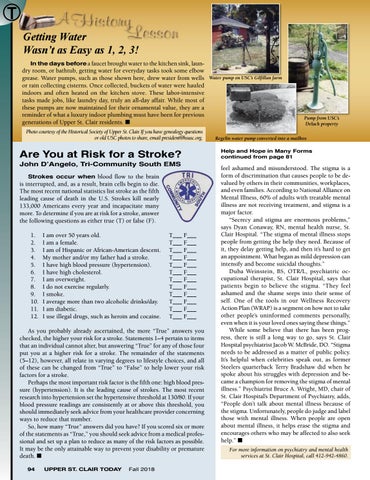Getting Water Wasn’t as Easy as 1, 2, 3! In the days before a faucet brought water to the kitchen sink, laundry room, or bathtub, getting water for everyday tasks took some elbow grease. Water pumps, such as those shown here, drew water from wells or rain collecting cisterns. Once collected, buckets of water were hauled indoors and often heated on the kitchen stove. These labor-intensive tasks made jobs, like laundry day, truly an all-day affair. While most of these pumps are now maintained for their ornamental value, they are a reminder of what a luxury indoor plumbing must have been for previous generations of Upper St. Clair residents. n Photo courtesy of the Historical Society of Upper St. Clair. If you have genealogy questions or old USC photos to share, email president@hsusc.org.
Are You at Risk for a Stroke? John D’Angelo, Tri-Community South EMS Strokes occur when blood flow to the brain
is interrupted, and, as a result, brain cells begin to die. The most recent national statistics list stroke as the fifth leading cause of death in the U.S. Strokes kill nearly 133,000 Americans every year and incapacitate many more. To determine if you are at risk for a stroke, answer the following questions as either true (T) or false (F). 1. 2. 3. 4. 5. 6. 7. 8. 9. 10. 11. 12.
I am over 50 years old. I am a female. I am of Hispanic or African-American descent. My mother and/or my father had a stroke. I have high blood pressure (hypertension). I have high cholesterol. I am overweight. I do not exercise regularly. I smoke. I average more than two alcoholic drinks/day. I am diabetic. I use illegal drugs, such as heroin and cocaine.
T___ F___ T___ F___ T___ F___ T___ F___ T___ F___ T___ F___ T___ F___ T___ F___ T___ F___ T___ F___ T___ F___ T___ F___
As you probably already ascertained, the more “True” answers you checked, the higher your risk for a stroke. Statements 1–4 pertain to items that an individual cannot alter, but answering “True” for any of those four put you at a higher risk for a stroke. The remainder of the statements (5–12), however, all relate in varying degrees to lifestyle choices, and all of these can be changed from “True” to “False” to help lower your risk factors for a stroke. Perhaps the most important risk factor is the fifth one: high blood pressure (hypertension). It is the leading cause of strokes. The most recent research into hypertension set the hypertensive threshold at 130/80. If your blood pressure readings are consistently at or above this threshold, you should immediately seek advice from your healthcare provider concerning ways to reduce that number. So, how many “True” answers did you have? If you scored six or more of the statements as “True,” you should seek advice from a medical professional and set up a plan to reduce as many of the risk factors as possible. It may be the only attainable way to prevent your disability or premature death. n 94
UPPER ST. CLAIR TODAY
Fall 2018
Water pump on USC’s Gilfillan farm
Pump from USC’s Delach property Regelin water pump converted into a mailbox Help and Hope in Many Forms continued from page 81
feel ashamed and misunderstood. The stigma is a form of discrimination that causes people to be devalued by others in their communities, workplaces, and even families. According to National Alliance on Mental Illness, 60% of adults with treatable mental illness are not receiving treatment, and stigma is a major factor. “Secrecy and stigma are enormous problems,” says Dyan Conaway, RN, mental health nurse, St. Clair Hospital. “The stigma of mental illness stops people from getting the help they need. Because of it, they delay getting help, and then it’s hard to get an appointment. What began as mild depression can intensify and become suicidal thoughts.” Duba Weinstein, BS, OTR/L, psychiatric occupational therapist, St. Clair Hospital, says that patients begin to believe the stigma. “They feel ashamed and the shame seeps into their sense of self. One of the tools in our Wellness Recovery Action Plan (WRAP) is a segment on how not to take other people’s uninformed comments personally, even when it is your loved ones saying these things.” While some believe that there has been progress, there is still a long way to go, says St. Clair Hospital psychiatrist Jacob W. McBride, DO. “Stigma needs to be addressed as a matter of public policy. It’s helpful when celebrities speak out, as former Steelers quarterback Terry Bradshaw did when he spoke about his struggles with depression and became a champion for removing the stigma of mental illness.” Psychiatrist Bruce A. Wright, MD, chair of St. Clair Hospital’s Department of Psychiatry, adds, “People don’t talk about mental illness because of the stigma. Unfortunately, people do judge and label those with mental illness. When people are open about mental illness, it helps erase the stigma and encourages others who may be affected to also seek help.” n For more information on psychiatry and mental health services at St. Clair Hospital, call 412-942-4860.
